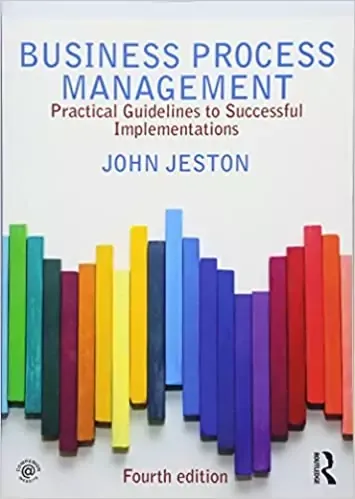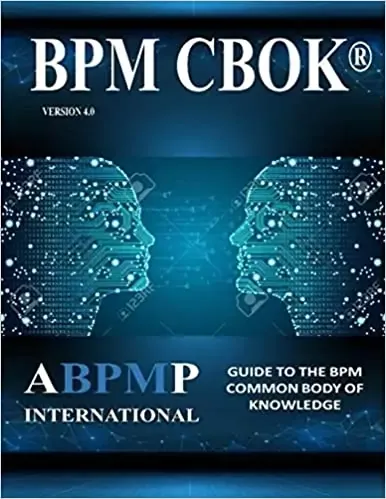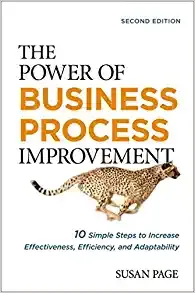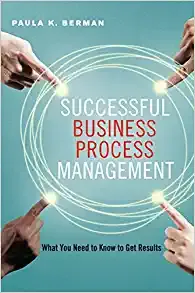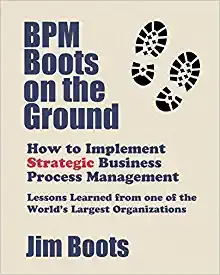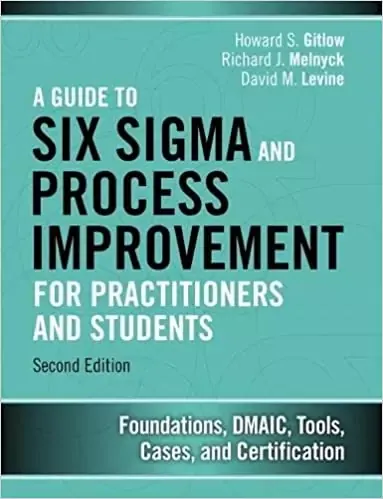Welcome to an insightful journey through the '15 Best Business Process Management Books,' written by
Muhiuddin Alam on the book recommendations and reviews site,
ReadingAndThinking.com.
I have received many requests to recommend some of the business process management books. In response, I'm pleased to offer my expert recommendations in this article.
I will recommend you best books on business process management in this post, which is based on my in-depth study and testing in this field.
Such as Business Process Management, BPM CBOK Version 4.0, The Ultimate Guide to Business Process Management, Fundamentals of Business Process Management, The Power of Business Process Improvement, Successful Business Process Management, Business Process Change, and High-Performance Through Business Process Management.
These aren't the only books on this topic. Below, you'll find 15 books with detailed descriptions of each of these outstanding resources, helping you make well-informed decisions in your process improvement book journey.
Businesses continue with outdated and wasteful processes because it's always been done that way.
This causes pain. It means information is difficult to get informed decisions are impossible to make and it's hard to get a good night's sleep. Effective Business Process Management (BPM) solves these problems.
It's the art and science of analyzing measuring and optimizing every process in your business that keeps it running smoothly.
15 Best Business Process Management Books to Read in 2024
The truth is Business Process Management used to be expensive and inflexible and took a long time to set up with very limited success. Fortunately, BPM has evolved. An intelligent BPM system creates more value with less waste and fewer resources quickly.
In practice, this means increased speed and consistency improved customer experiences the ability to handle exceptions faster and with fewer errors greater transparency, and seamless compliance.
Using low-code applications forward-thinking businesses can reduce repetitive tasks improve processing times and make companies more agile in response to changing environments quickly and inexpensively.
Below all Business Process Management allows your business and the behavior of your people to evolve faster than your competitors it guarantees a sustainably profitable future for your business and a good night's sleep for everyone from your CEO to your most junior administrator.
1. Business Process Management
Business Process Management: Practical Guidelines to Successful Implementations by John Jeston
Business Process Management, a huge bestseller, has helped thousands of leaders and BPM practitioners successfully implement BPM projects, enabling them to add measurable value to their organizations.
The book’s runaway success can be attributed partly to its overview of all major useful frameworks (such as LEAN and Six Sigma) without over-investment in one over another, and a unique emphasis on BPM’s interrelationship with organizational management, culture, and leadership.
Its common-sense approach teaches how BPM must be well-integrated across an entire business if it’s to be successful: augmented and aligned with other management disciplines.
This highly anticipated fourth edition brings Jeston’s practicable frameworks and solutions up to date with the latest developments in BPM, including the robotics process automation, digital strategies, and the changes necessary as a result of the impact of the quad generations in the workforce.
This thoroughly revised and updated new edition includes:
- Enhanced BPM House noting the importance of traceability from strategy to execution activities
- New and revised case studies
- An analysis of the risks and benefits of robotic automation and cognitive computing.
The book highlights that millennials will be 50% of the global workforce in 2020 and 67% by 2025―Jeston warns managers to ignore them at their peril. Business processes and the way work is performed must evolve!
This book will prove to be an indispensable guide to any senior business executive or chief financial officer while providing practical BPM examples to undergraduate and postgraduate students alike.
2. BPM CBOK Version 4.0
BPM CBOK Version 4.0: Guide to the Business Process Management Common Body of Knowledge by Tony Benedict
This Guide to the BPM Common Body of Knowledge is a fundamental reference for anyone who practices Business Process Management. The primary purpose of this guide is to provide BPM practitioners the fundamental Knowledge Areas, skills, and competencies that are generally recognized and accepted as common, best practices.
The Guide to the BPM CBOK provides a general overview of each Knowledge Area and discusses the skills and competencies necessary to become proficient in the practice of BPM. It also provides links and references to other sources of information that are part of the broader BPM Common Body of Knowledge.
New topics covered:
- Strategic Alignment and Business Architecture
- Strategy to Execution using the BPM Life Cycle Framework
- Leadership, Organizational Design, Project and Change Management
- Evolution of iBPMS:
- Process Mining and Case Management
- Robotic Process Automation
- Big Data Analytics
- Blockchain
- Artificial Intelligence, Machine Learning, Deep Learning
- Internet of Things.
3. The Ultimate Guide to Business Process Management
The Ultimate Guide to Business Process Management: Everything You Need to Know and How to Apply it to Your Organization by Theodore Panagakos
In this step-by-step guide, former Management Consultant and change management expert Theodore Panagacos walks you through the entire discipline of Business Process Management.
Learn how to fast-track your organization's strategy to govern processes, create a process culture, and measure business performance. Best of all, this crystal-clear, convenient-sized book can be put to work in your organization immediately!
4. Fundamentals of Business Process Management
This textbook covers the entire Business Process Management (BPM) lifecycle, from process identification to process monitoring, covering along the way process modeling, analysis, redesign, and automation.
Concepts, methods, and tools from business management, computer science, and industrial engineering are blended into one comprehensive and interdisciplinary approach. The presentation is illustrated using the BPMN industry standard defined by the Object Management Group and widely endorsed by practitioners and vendors worldwide.
In addition to explaining the relevant conceptual background, the book provides dozens of examples, more than 230 exercises – many with solutions – and numerous suggestions for further reading.
This second edition includes extended and completely revised chapters on process identification, process discovery, qualitative process analysis, process redesign, process automation, and process monitoring.
A new chapter on BPM as an enterprise capability has been added, which expands the scope of the book to encompass topics such as the strategic alignment and governance of BPM initiatives.
The textbook is the result of many years of combined teaching experience of the authors, both at the undergraduate and graduate levels as well as in the context of professional training.
Students and professionals from both business management and computer science will benefit from the step-by-step style of the textbook and its focus on fundamentals of business process management concepts and proven methods. Lecturers will appreciate the class-tested format and the additional teaching material available on the accompanying website.
5. The Power of Business Process Improvement
The Power of Business Process Improvement: 10 Simple Steps to Increase Effectiveness, Efficiency, and Adaptability by Susan Page
Are you baffled by how your department can keep making the same mistakes? Do you feel you have been climbing an unending, uphill battle trying to focus your employees’ limited time on more valuable work? You’re not alone! In fact, these obstacles are so common in business that the solution to getting past them even has a name--business process improvement (BPI).
Thankfully, though, you don’t have to be a BPI expert in order to resolve these situations and find the results your business needs to find success again. Written by an experienced process analyst,
The Power of Business Process Improvement is the resource you need to find a simple, bottom-line approach to process improvement work. By implementing its proven 10-step method.
you will be able to:
- Eliminate duplication and bureaucracy
- Control costs
- Establish internal controls to reduce human error
- Test and rework the process before introducing it
- Implement the changes whether you are new to BPI or a seasoned pro,
this user-friendly how-to guide--complete with software suggestions, quizzes, a comparison of industry improvement methods, and examples to help you apply the ideas--is your solution to turning your business into the well-oiled machine you know it can be.
6. Successful Business Process Management
Successful Business Process Management: What You Need to Know to Get Results by Paula Berman
Too few standard procedures within an organization and inefficiency will inevitably ensue. But too many, and creativity is stifled. This catch-22 is enough to make heads spin! How does one settle on the perfect mix that will streamline activities and create smooth workflows?
Successful Business Process Management has done all the homework for you and provides a succinct, accessible overview of the training and tools available for process improvement that fills that gap of being not too rigid nor too blasé.
Step-by-step instructions explain how to:
- Overcome resistance and apathy to standard procedures
- Take a systematic rather than ad hoc approach to process management
- Design key processes and capture them in documented procedures
- Revise existing processes when feasible
- Roll out the changes so people know what to do
- Embed them in the organization for reliable outcomes with the increasingly complex organizations of the twenty-first century
it is vital that companies have standard, documented processes and procedures in order to achieve high levels of quality and productivity--yet they can’t afford to dampen the innovativeness that got them on the map in the first place. In Successful Business Process Management learn how to get it just right.
7. Business Process Change
Business Process Change: A Business Process Management Guide for Managers and Process Professionals by Paul Harmon
Business Process Change: A Business Process Management Guide for Managers and Process Professionals, Fourth Edition, provides a balanced view of the field of business process change.
Bestselling author and renowned expert in the field Paul Harmon offers concepts, methods, and cases for all aspects, and phases of successful business process improvement.
Students and professionals alike will benefit from the comprehensive coverage and customizable, integrated approach to broad business process management that focuses on improving efficiency and productivity.
In this updated Edition, particular attention is paid to the impact of disruptive technology on business and the need for agile transformation.
8. High Performance Through Business Process Management
High Performance Through Business Process Management: Strategy Execution in a Digital World by Mathias Kirchmer
This management book presents value-driven business process management as a successful discipline to turn strategy into people- and technology-based execution, quickly and at minimal risk. It shows how to achieve high performance successfully in a digital business environment.
Static business models do not keep pace with the dynamic changes in our digital world. Organizations need a management approach that fits this environment and capitalizes on its opportunities while minimizing the related risks. They need to execute their business strategy fast and reliably.
In effect, they have to know how and when to modify or enhance their business processes, which processes are the best candidates for intervention, and how to move rapidly from strategy to execution.
This means organizations need to establish business process management as a real management discipline. The importance of process innovation, digital technology, and people aspects, process governance, internationalization, emerging processes, and the unique situation in mid-market organizations are some of the key topics discussed in this book. It ends with a comprehensive case study and a discussion about what process engineers can learn from jazz musicians.
9. Operations and Process Management
Operations and Process Management: Principles and Practice for Strategic Impact By Nigel Slack
Everyone manages processes ...Everyone is an operations manager
"...integrates services and manufacturing operations further than has been done before in any Operations Management textbook. This makes the book ideally suited for an MBA audience; who come from a multitude of organizational settings." --Par Ahlstrom, Professor of Operations Management, Chalmers University of Technology.
"This text places operations management clearly in context. I particularly like the emphasis on process management as a means of demonstrating the ubiquity of processes, even outside the traditional operations areas." --Dr. Alison Smart, Manchester Business School, University of Manchester.
"This comprehensive text shows how persuasive, relevant and exciting Operations Management is to business and everyday life." --Stephen Disney, Cardiff Business School Written by best-selling authors in their field
Operations and Process Management 2einspires a critical and applied mastery of the core principles and processes fundamental to managing business operations.
Approaching the subject from a truly managerial perspective, this brand new text provides clear and concise coverage, whilst the fully updated accompanying CD provides an opportunity to practice and further explore the concepts and techniques introduced.
10. Reimagining Management
Reimagining Management: Putting Process at the Center of Business Management by Roger Tregear
This book provides a straightforward, practical explanation of the theory, practice, and benefits of process-based management.
Reviewers from across the globe have praised this book. Reimagining Management:
“superb reference book that shows how to establish and implement BPM in any organization”
“modern classic for the BPM space!’
“Roger has unlocked the mystery of business process management”
“Reimagining Management defines the missing link”
Organizations need to step back from day-to-day functional issues and reimagine themselves as value-creation and delivery flows. Management needs its own disruption; the first transformation required is of management itself.
A core principle of Reimagining Management is the primacy of process. This principle says that the only way any organization can create, accumulate, and deliver value to its customers, itself, and other stakeholders, is through collaboration across the organization.
Reimagining Management introduces the concepts of the 7Enablers of BPM and the Tregear Circles as part of a practical framework for the positive and controlled evolution of management practice; an approach to organizational management that focuses on the creation, accumulation, and delivery of value to customers and other stakeholders.
Using this book as a guide, it’s time to reimagine management.
11. BPM Boots on the Ground
BPM Boots on the Ground: How to Implement Strategic Business Process Management: Lessons Learned from one of the World's Largest Organizations by Jim Boots
In the decade after the publication of the seminal book, Business Process Management: The Third Wave, much has been written about BPM concepts and vision. Yet Zen Master Thich Nhat Hanh teaches us, “Once there is seeing, there must be acting. Otherwise, what is the use of seeing?”
Finally, now comes the first real-world story that shares the lessons learned by doing the work of strategic BPM in one of the world’s largest organizations. Don’t just read this book; apply the hard-earned lessons in your organization.
“Jim Boots makes clear the things that people need to do differently to manage for sustainable excellence. And he does not gloss over the challenges related to behavioral change. Rather, backed up by examples and stories, he explains how to overcome resistance and engage people at all levels to make BPM ‘the way we do things here." --Julie M. Smith, Ph.D., Co-founder of CLG
“This book provides the kind of deep and broad coverage of BPM that only an experienced practitioner like Jim could provide. The result is a source of deep learning for BPM professionals and a comprehensive overview of the topic for those who want to learn more about BPM.” --Prof. Brian Donnellan, Co-Director, Innovation Value Institute
“They say the key to many challenges, like climbing Mount Everest or running the four-minute mile, lies in knowing for certain it can be done. Once someone has done it, then, suddenly many others are confident enough to do it too. Jim shows how an organization can wring productivity out of business operations with hard work and constant attention to detail. Reading about what Jim and his colleagues at Chevron have accomplished may very well empower you to do something similar at your organization.” --Paul Harmon, Executive Editor, BPTrends
“The need for business process management is one constant in an era of continuous change. Jim Boots’ book is a lighthouse to help executives find their way to success.” --Prof. Martin Curley, Vice-President and Director, Intel Labs Europe, Intel Corporation
12. Business Process Management
Business Process Management: The Next Wave by Jim Sinur
Technology marches on, bringing new dangers—and new opportunities. As cloud computing, social, mobile, big data, predictive analytics, and the Internet of Things are baked into more and more business processes, they will rapidly reshape how business gets done, today and tomorrow. Today companies are struggling to come to grips with these forces that introduce unprecedented complexity.
Business Process Management (BPM) has delivered benefits over a long period of time and continues to do so. But as process scopes expand to meet the nexus of these forces, BPM needs to be enhanced and extended in order to harness the exploding complexity to gain a competitive advantage.
Using chaordic principles, the astute manager can embrace the chaos and order that make complexity “complex,” in order to build a stronger business. The balancing act between chaos and order must be managed properly—or the organization will fall.
The idea of having all the intelligence centrally managed and delivered is outmoded and challenging, if not impossible. This book provides insights and strategies for transforming current centralized BPM approaches by exploiting decentralized, distributed intelligence in the form of intelligent agent technology.
Agent-oriented BPM (ao BPM) will allow BPM to take on all of what is expected of it, as organizations accelerate growth and connect better with their customers while providing greater agility and near real-time responses.
This book provides a starting point that will help you know what is coming, and how to think about addressing it. It’s about your organization’s journey toward the future.
And as William Gibson wrote in The Economist, “The future is already here—it’s just not evenly distributed.” Sinur, Odell, and Fingar, seasoned business-technology thought leaders, are just the right mix to interweave these concepts. The time is ripe for ao BPM, and this book is a telling and timely way to introduce it.
We need to connect the dots between BPM, knowledge management, and analytics, especially in a world in which mobile and social technologies have transformed how people work and live. The authors argue that intelligent agent technology is now needed to manage the new complexities going forward.
I believe the authors are setting the stage for the next wave of BPM a wave that you cannot afford to miss. Go forth and learn to surf it! Thomas H. Davenport Distinguished Professor of IT and Management, Babson College Co-Founder and Research Director, International Institute for Analytics Research Fellow, MIT Center for Digital Business Senior Advisor to Deloitte Analytics.
13. Business Process Management
Business Process Management: Concepts, Languages, Architectures by Mathias Weske
Business process management is usually treated from two different perspectives: business administration and computer science. While business administration professionals tend to consider information technology as a subordinate aspect in business process management for experts to handle, in contrast, computer science professionals often consider business goals and organizational regulations as terms that do not deserve much thought but require the appropriate level of abstraction.
Matthias Weske argues that all communities involved need to have a common understanding of the different aspects of business process management. To this end, he details the complete business process lifecycle from the modeling phase to process enactment and improvement, taking into account all the different stakeholders involved.
After starting with a presentation of general foundations and abstraction models, he explains concepts like process orchestrations and choreographies, as well as process properties and data dependencies.
Finally, he presents both traditional and advanced business process management architectures, covering, for example, workflow management systems, service-oriented architectures, and data-driven approaches. In addition, he shows how standards like WfMC, SOAP, WSDL, and BPEL fit into the picture.
This textbook is ideally suited for classes on business process management, information systems architecture, and workflow management. This 3rd edition contains a new chapter on business decision modeling, covering the Decision Model and Notation (DMN) standard; the chapter on process choreographies has been streamlined, and numerous clarifications have been fetched throughout the book.
14. Guide to Six Sigma and Process Improvement for Practitioners and Students
Guide to Six Sigma and Process Improvement for Practitioners and Students, A: Foundations, DMAIC, Tools, Cases, and Certification by Howard Gitlow
Master modern Six Sigma implementation with the most complete, up-to-date guide for Green Belts, Black Belts, Champions, and students! Now fully updated with the latest lean and process control applications.
A Guide to Lean Six Sigma and Process Improvement for Practitioners and Students, Second Edition gives you a complete executive framework for understanding quality and implementing Lean Six Sigma.
Whether you're a green belt, black belt, champion, or student, Howard Gitlow and Richard Melnick cover all you need to know. Step by step, they systematically walk you through the five-step DMAIC implementation process, with detailed examples and many real-world case studies.
You'll find practical coverage of Six Sigma statistics and management techniques, from dashboards and control charts to hypothesis testing and experiment design. Drawing on their extensive experience consulting on Six Sigma and leading major Lean and quality initiatives, Gitlow and Melnyck offer up-to-date coverage of:
What Six Sigma can do, and how to manage it effectively
- Six Sigma roles, responsibilities, and terminology
- Running Six Sigma programs with Dashboards and Control Charts
- Mastering each DMAIC phase: Define, Measure, Analyze, Improve, Control
- Understanding foundational Six Sigma statistics: probability, probability distributions, sampling distributions, and interval estimation
- Pursuing Six Sigma Champion or Green Belt Certification, and more
This guide will be an invaluable resource for everyone who is currently involved in Six Sigma implementation or plans to be. It's ideal for students in quality programs; "Green Belts" who project manage Six Sigma implementations, "Black Belts" who lead Six Sigma teams; "Champions" who promote and coordinate Six Sigma at the executive level; and anyone seeking Six Sigma certification.
15. The Basics of Process Mapping
The bestselling first edition of this influential resource has been incorporated into the curriculum at forward-thinking colleges and universities, a leading vocational technical institute, many in-house corporate continuous improvement approaches, and the United Nations headquarters. Providing a complete and accessible introduction to process maps, The Basics of Process Mapping, Second Edition raises the bar on what constitutes the basics.
Thoroughly revised and updated to keep pace with recent developments, it explains how relationship maps, cross-functional process maps (swimlane diagrams), and flowcharts can be used as a set to provide different views of work.
New in the Second Edition: Four new chapters and 75 new graphics An introduction to the concepts of flow and waste and how both appear in knowledge work or business processes A set of measures for flow and waste A discussion of problematic features of knowledge work and business processes that act as barriers to flow Seven principles and 29 guidelines for improving the flow of knowledge work.
A detailed (actual) case study that shows how one organization applied the principles and guidelines to reduce lead time from an average of 28 days to 4 days Unlike "tool books" or "pocket guides" that focus on discrete tools in isolation, this text uses a single comprehensive service work example that integrates all three maps and illustrates the insights they provide when applied as a set.
It contains how-to procedures for creating each type of map and includes clear-cut guidance for determining when each type of map is most appropriate. The well-rounded understanding provided in these pages will allow readers to effectively apply all three types of maps to make work visible at the organization, process, and job/ performer levels.
Know someone who might be interested in this article? Share it with them.


